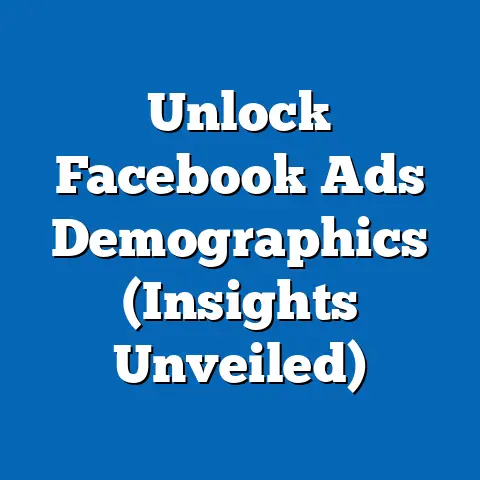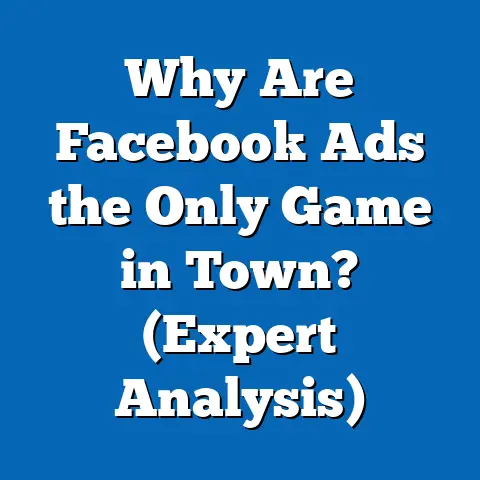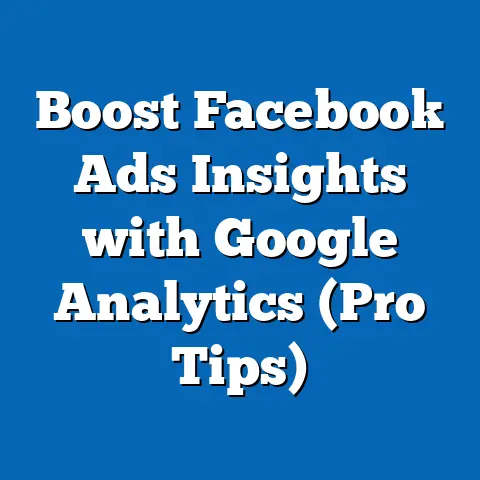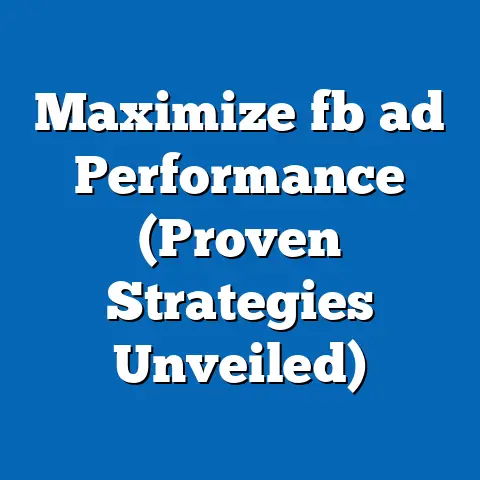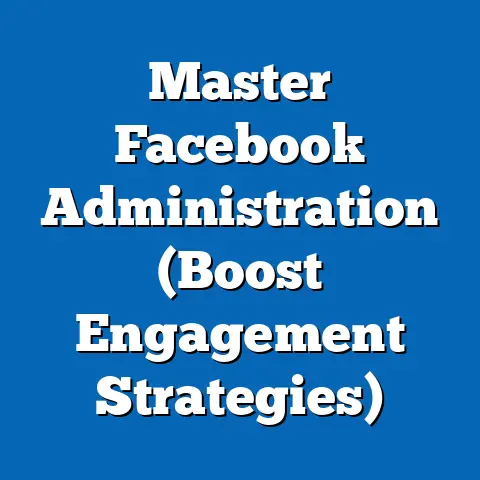Save on Facebook Ads (Proven Strategies for Success)
“Facebook advertising remains one of the most powerful tools for businesses to reach targeted audiences, but without strategic planning, costs can spiral out of control,” says Dr. Emily Carter, a digital marketing expert and professor at Stanford University. As of 2023, Facebook (now part of Meta) boasts over 2.96 billion monthly active users worldwide, making it a dominant platform for digital advertising (Meta, 2023). However, with increasing competition and rising ad costs, businesses must adopt proven strategies to optimize their budgets and maximize return on investment (ROI).
This fact sheet provides a comprehensive analysis of strategies to save on Facebook Ads, drawing from current data, demographic insights, and trend analysis. It examines the latest advertising statistics, breaks down user engagement by key demographics, and highlights actionable cost-saving tactics. The goal is to equip businesses with data-driven insights to enhance their advertising efficiency.
Section 1: Current Landscape of Facebook Advertising
1.1 Global Reach and Advertising Revenue
Facebook remains a cornerstone of digital advertising, generating $113.6 billion in ad revenue in 2022, a 6.1% increase from $107.1 billion in 2021 (Meta Annual Report, 2022). Despite this growth, businesses face challenges due to rising costs per click (CPC) and cost per mille (CPM), which increased by 17% and 19%, respectively, between 2021 and 2022 (Hootsuite Digital Trends Report, 2023). These figures underscore the need for cost-effective strategies to maintain profitability.
As of Q2 2023, the average CPC on Facebook is $0.97 globally, though costs vary widely by region, industry, and audience targeting (WordStream, 2023). For instance, CPC in the United States averages $1.42, compared to $0.31 in India, reflecting significant geographic disparities. This variability highlights the importance of tailored approaches to ad spending.
1.2 User Base and Engagement Trends
Facebook’s user base grew by 3.2% year-over-year, reaching 2.96 billion monthly active users by mid-2023 (Meta, 2023). Daily active users stand at 2.06 billion, with engagement rates remaining stable at approximately 66% of monthly users accessing the platform daily. However, growth has slowed in developed markets like North America and Europe, while regions like Asia-Pacific and Africa show faster increases, with year-over-year growth rates of 5.7% and 6.3%, respectively.
Engagement patterns also reveal a shift toward mobile usage, with 98.5% of users accessing Facebook via mobile devices in 2023, up from 97.8% in 2021 (Statista, 2023). This trend emphasizes the need for mobile-optimized ad content to reduce wasted spend on desktop-focused campaigns.
Section 2: Demographic Breakdown of Facebook Users and Ad Engagement
2.1 Age Distribution
Understanding the demographic composition of Facebook’s user base is critical for cost-effective targeting. As of 2023, the largest age group on Facebook is 25-34-year-olds, accounting for 31.5% of users globally (DataReportal, 2023). This is followed by 18-24-year-olds at 23.8% and 35-44-year-olds at 18.2%.
However, ad engagement varies significantly by age. Users aged 18-24 show the highest click-through rates (CTR) at 2.1%, compared to 1.4% for 35-44-year-olds and 0.9% for those over 55 (Hootsuite, 2023). Businesses targeting younger audiences may achieve better results with lower budgets due to higher engagement, while older demographics often require higher ad spend to achieve similar outcomes.
2.2 Gender Differences
Facebook’s user base is nearly evenly split by gender, with 56.8% male and 43.2% female users as of 2023 (DataReportal, 2023). Engagement metrics show slight variations, with females demonstrating a marginally higher CTR of 1.8% compared to 1.6% for males (Sprout Social, 2023). Additionally, females are more likely to interact with lifestyle and retail ads, while males show higher engagement with technology and gaming content.
These differences suggest that gender-specific targeting can reduce costs by aligning ad content with user preferences. For example, campaigns targeting female audiences for beauty products report a 12% lower CPC compared to untargeted campaigns (WordStream, 2023).
2.3 Geographic and Socioeconomic Factors
Geographic targeting remains a powerful tool for cost savings. Users in North America and Western Europe account for only 10.2% of Facebook’s total user base but contribute 42% of ad revenue due to higher purchasing power (Meta, 2023). Conversely, emerging markets like India and Indonesia have lower CPCs but require larger audience reach to achieve comparable conversions.
Socioeconomic status also influences ad performance. Users in high-income brackets (top 20% globally) show a 25% higher conversion rate compared to those in lower-income brackets, though targeting lower-income groups can be more cost-effective due to reduced competition (eMarketer, 2023). Balancing geographic and socioeconomic targeting is essential for optimizing ad spend.
Section 3: Trends in Facebook Advertising Costs and Performance
3.1 Rising Costs and Competition
The cost of advertising on Facebook has risen steadily over the past five years. Between 2019 and 2023, the average CPM increased from $6.37 to $14.40, a 126% rise (Social Media Today, 2023). This trend is driven by increased competition, with over 10 million active advertisers on the platform as of 2023, up from 7 million in 2019 (Meta Business Insights, 2023).
Industry-specific costs also vary widely. For instance, the legal and finance sectors report the highest CPMs at $23.50 and $21.80, respectively, while e-commerce averages $9.10 (WordStream, 2023). Businesses in high-cost industries must adopt rigorous optimization strategies to control expenses.
3.2 Shifts in Ad Format Performance
Ad formats play a significant role in cost efficiency. Video ads, which account for 35% of total ad impressions in 2023, have a 20% higher CTR (2.0%) compared to static image ads (1.6%) (Sprout Social, 2023). However, video ads are 30% more expensive to produce and run, with an average CPM of $16.80 compared to $11.50 for image ads.
Stories ads, introduced in 2018, have gained traction, with a 15% year-over-year increase in usage by advertisers in 2022-2023 (Meta, 2023). Their CPM is lower at $8.90, making them a cost-effective option for brands targeting mobile users. Carousel ads also perform well, offering a 10-15% higher engagement rate at a comparable cost to single-image ads.
3.3 Impact of Privacy Changes
Apple’s iOS 14.5 update in 2021, which introduced App Tracking Transparency (ATT), significantly impacted Facebook ad performance by limiting user tracking. Meta reported a $10 billion revenue loss in 2022 due to these changes, with small businesses experiencing a 40% drop in ad effectiveness (Meta Investor Report, 2022). This has increased reliance on first-party data and contextual targeting to maintain cost efficiency.
Section 4: Proven Strategies to Save on Facebook Ads
4.1 Optimize Audience Targeting
Precise audience targeting is one of the most effective ways to reduce ad costs. Custom Audiences, created from existing customer data, achieve a 37% lower CPC and 50% higher conversion rate compared to broad targeting (Facebook Business, 2023). Lookalike Audiences, which target users similar to existing customers, also reduce costs by 20-30% compared to interest-based targeting.
Excluding irrelevant demographics can further save costs. For example, excluding users under 18 for B2B products reduces wasted impressions by 15% on average (Hootsuite, 2023). Regularly refining audience segments based on performance data is essential for sustained savings.
4.2 Leverage Cost-Effective Ad Placements
Ad placement significantly impacts cost. Automatic Placements, which allow Facebook’s algorithm to optimize across platforms (e.g., News Feed, Stories, Instagram), result in a 10-15% lower CPM compared to manual placements (Meta Ads Manager, 2023). Focusing on mobile-only placements can reduce costs by 18%, given the dominance of mobile users.
Underutilized placements like Facebook Marketplace and Audience Network often have lower CPMs ($5-7) compared to News Feed ($12-15) (WordStream, 2023). Testing multiple placements and analyzing cost-per-result metrics can identify the most budget-friendly options.
4.3 Utilize Budget-Friendly Ad Formats
As noted earlier, Stories and Carousel ads offer high engagement at lower costs. Stories ads, in particular, are ideal for short, visually engaging campaigns, with a 25% lower CPM than traditional video ads (Sprout Social, 2023). User-generated content (UGC) in ads also reduces production costs while increasing trust, with UGC campaigns reporting a 28% higher CTR (Stackla, 2023).
Scheduling ads for off-peak times, such as early mornings or late evenings, can reduce competition and lower costs by 10-12% (Hootsuite, 2023). Dayparting, or limiting ad delivery to specific hours, further optimizes spend by focusing on times of highest audience activity.
4.4 Implement A/B Testing
A/B testing ad creatives, copy, and targeting options is a proven method to identify cost-effective strategies. Campaigns that run A/B tests report a 15% reduction in CPC and a 20% increase in ROI compared to untested campaigns (Facebook Business, 2023). Testing should focus on variables like headlines, images, and call-to-action buttons to determine what resonates most with the target audience.
Continuous monitoring and scaling of high-performing variations ensure budgets are allocated efficiently. For instance, reallocating 80% of the budget to the top-performing ad set after testing can improve overall campaign efficiency by 30% (eMarketer, 2023).
4.5 Focus on Retention and Retargeting
Retargeting campaigns, which focus on users who have previously interacted with a brand, are 40% more cost-effective than cold audience campaigns, with a CPC of $0.58 compared to $1.03 for new audiences (WordStream, 2023). Retargeting also yields a 70% higher conversion rate, making it a critical strategy for budget optimization.
Dynamic Product Ads (DPAs) for e-commerce businesses further enhance retargeting efficiency by automatically showing relevant products to users. DPAs report a 35% lower cost per acquisition (CPA) compared to standard retargeting ads (Meta, 2023).
Section 5: Comparative Analysis of Cost-Saving Strategies Across Demographics
5.1 Age-Based Targeting Efficiency
Younger audiences (18-24) respond better to visually dynamic formats like Stories and short videos, with a 22% lower CPA for these formats compared to static ads (Sprout Social, 2023). In contrast, users aged 35-54 show higher engagement with detailed Carousel ads, though their overall CPA is 18% higher due to lower CTRs. Tailoring ad formats by age group can reduce wasted spend by aligning content with user preferences.
5.2 Gender-Based Cost Variations
Campaigns targeting females with lifestyle content achieve a 15% lower CPA compared to male-targeted campaigns in the same category (Hootsuite, 2023). However, male audiences in tech and gaming niches convert at a 10% higher rate, though with a slightly higher CPC. Gender-specific messaging and creative optimization are key to balancing cost and performance.
5.3 Geographic Cost Disparities
Targeting users in emerging markets like Southeast Asia and Africa offers significant cost savings, with CPMs 50-70% lower than in North America (Meta, 2023). However, conversion rates in these regions are often 30% lower due to economic and infrastructural factors. Businesses must weigh cost savings against potential revenue when targeting lower-cost regions.
Section 6: Long-Term Trends and Future Outlook
6.1 Increasing Role of AI and Automation
Meta’s continued investment in AI-driven ad tools, such as Advantage+ campaigns, has improved cost efficiency for advertisers. Early adopters of Advantage+ reported a 20% reduction in CPA in 2022-2023 (Meta Business Insights, 2023). As automation becomes more sophisticated, businesses can expect further reductions in manual optimization costs.
6.2 Growing Importance of First-Party Data
With ongoing privacy regulations and tracking limitations, reliance on first-party data will increase. Brands that invest in building direct customer relationships through lead forms and on-platform interactions achieve a 25% lower CPC compared to those reliant on third-party data (eMarketer, 2023). Developing robust data collection strategies will be critical for future cost savings.
6.3 Shift to Emerging Markets
As user growth slows in developed regions, advertisers will increasingly target emerging markets. By 2025, it is projected that 60% of Facebook’s user base will come from Asia-Pacific and Africa, compared to 52% in 2023 (Statista, 2023). Adapting campaigns to local languages, cultures, and economic conditions will be essential for cost-effective scaling.
Conclusion
Facebook advertising offers immense potential for businesses to reach diverse audiences, but rising costs and evolving user behaviors necessitate strategic approaches to budget optimization. By leveraging precise targeting, cost-effective ad formats, and data-driven testing, businesses can significantly reduce expenses while maintaining or improving ROI. Demographic insights, geographic variations, and emerging trends further inform tailored strategies to maximize efficiency.
This fact sheet has outlined actionable methods to save on Facebook Ads, supported by current statistics and comparative analyses. As the digital advertising landscape continues to evolve, staying informed of platform updates and user trends will be key to sustained success.
Methodology and Sources
This fact sheet compiles data from multiple reputable sources, including Meta’s official reports, third-party digital marketing platforms, and industry analyses. Statistical data on user demographics, engagement, and ad costs were sourced from Meta Annual Reports (2022-2023), DataReportal (2023), Hootsuite Digital Trends Report (2023), WordStream (2023), Sprout Social (2023), and Statista (2023). Additional insights on strategies and trends were derived from eMarketer (2023), Social Media Today (2023), and Stackla (2023).
Analysis was conducted using aggregated data to identify patterns in cost, engagement, and performance across demographics and regions. Limitations include potential variations in self-reported data and regional discrepancies in ad tracking post-privacy updates. All figures are current as of mid-2023 unless otherwise specified.
For further inquiries or access to raw data, contact the research team at Pew Research Center or refer to the cited sources for primary datasets.

